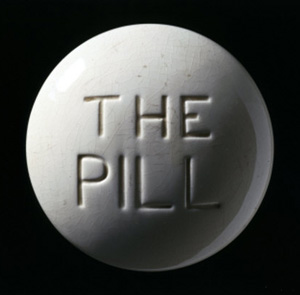Ironically, the Pill turned 50 on Mother’s Day. According to an article in last weekend’s edition of USA Today, the FDA approved the pill in the first year of the “swingin sixties.” However, it clears up misconceptions that the pill did not spark the sexual revolution; also contrary to common belief, it did not cause a sudden drop in the U.S. fertility rate at the time. At the time, there was also debate over whether it was going to promote promiscuity and lead to a decline in morals.
Andrea Tone, author of Devices and Desires: A History of Contraceptions in America, debunks this myth…
According to Tone, years before the pill became available, a 1953 Kinsey report on female sexual behavior found that half of all women had premarital sex. What the pill did do however, was place “the power to prevent pregnancy entirely in women’s hands.” And used it women have–2002 government data shows that more than 8 in 10 women ages 15-44 had taken the pill at some point in their lives.
Author of America and the Pill Elaine Tyler May thanks two women as “mothers of the pill.” In the 1920s, Margaret Sanger founded the predecessor of Planned Parenthood, the America Birth Control League, the first doctor-run birth control clinic. Along with activist Katherine McCormick, they “pushed and funded the scientists” Carl Djerassi and Gregory Pinicus, who are credited for inventing it.
May says that,”They knew that women could not achieve full equality unless they had control over their reproductive lives….<the pill> gave <women> unprecedented control over the timing and number of their pregnancies.”
It is hard to imagine that until the 1970s that all women, married and not, did not have legal access to contraception. When the pill first became available, it couldn’t be given to single women. It took a 1965 Supreme Court ruling, Griswold v Connecticut, to establish the right of married couples to use birth control, and then another Supreme Court decision in 1972 to ensure that unmarried people could access contraceptives as well. Like with Roe v Wade, the right to privacy drove the legal rationale. It is good to keep in mind, as we watch states like Oklahoma pass laws that strategically try to chip away at Roe v Wade, that it if it is ever overturned, it can open the door for those against the use of contraception to go after it too. And believe it or not, they are out there.
We’ve come a long way, but I agree with Lisa Hymas of grist.org that we still have a ways to go when it comes to contraceptive education and access. Also, not only does contraception create more full equality, but so does our attitude about reproduction. I still find it interesting that, as Dr. Ruth has said, while “the pill didn’t cause the sexual revolution, it was revolutionary,” the talk about it focuses on the power to be able to decide “when” to have a child, but not as a way to choose “whether” to have a child at all. Women will not achieve full equality until all of our reproductive decisions are talked about and accepted.
This goes for men too. And an effective male pill appears to be within reach. Several formulations are expected to become commercially available within the near future, but when asked will they take it, journalist John Schieszer writes in his msnbc article, “some say yes, some say only if their partners make them, and other say they would never even consider it.” What if women said that? But that’s talk for another post….

